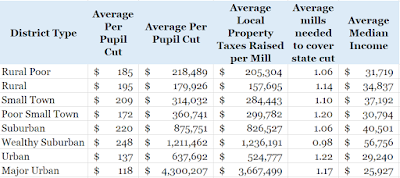All while protecting Charter Schools and vouchers, but that's another blog for another day.
Compounding the issue is the fact these cuts have come over the final three state payments to school districts from this year. So that's about $100 million off each payment for each of the final three payment periods.
That's a roughly 30 percent loss during the last three bi-monthly payments. Prior to the cuts, districts typically got about $336 million in their bi-monthly payments. Now it's about $236 million.
So that means districts have had to deal with essentially a 30 percent drop in their expected state aid during the height of the pandemic. That's bad for all districts and kids.
But if you want to see why the cuts still disproportionately harm kids in Ohio's neediest communities, look at the districts that lose the most money relative to their ability to offset those cuts using local revenue. A district-by-district spreadsheet of these cuts exists here.
As you can see from the chart I've put together, the average wealthy suburban district loses more per pupil funding and almost double the total funding of the average urban district. Seems fair, right?
Yet in order to cover that loss, the urban district has to come up with almost 25 percent more local funding than the wealthy district. And they have to come up with that money by asking folks who barely make half as much money.
Same goes for major urban districts -- Akron, Canton Columbus, Cleveland, Cincinnati, Dayton, Toledo, and Youngstown. Even though folks living there make substantially less than half of what folks living in wealthy suburban districts earn, they have to tax themselves at about a 20 percent higher rate than the wealthy communities do to cover the state losses.
Which community do you think has a better shot at recovering their lost state revenue with local revenue? That's a rhetorical question.
Is this outcome better than it could have been?
Absolutely.
The governor's office should be commended for doing what they could to try to make this distribution as fair as possible. But I think what this demonstrably proves is that there simply isn't enough money in wealthy districts to offset the disproportionate pain felt by our state's poorer communities when cuts come. And with more cuts expected for this coming school year, not to mention next year's biennial budget, the urgency of federal intervention to protect kids in our most vulnerable communities because clear and obvious.
In our poorest rural, small town and urban districts, folks who make substantially less money than folks in our wealthiest districts have to come up with substantially more local revenue to offset any state cuts -- regardless of state efforts to soften the blow.
This is why we need a school funding formula that makes sense and relies less on local revenue to fund schools. This is why the Ohio Supreme Court was absolutely correct when it ruled four times that the way Ohio funds schools is unconstitutional.
And, unfortunately, this is exactly why the system remains so 18 years after the final court ruling.
But on the immediate, COVID-emergency horizon, it speaks to the absolute necessity of federal funding to help alleviate this pain that will be felt in our most needy communities.
Congress -- specifically the Senate -- must act.
Now.


No comments:
Post a Comment
Note: Only a member of this blog may post a comment.